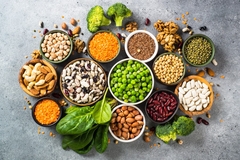“Mother nature’s full glory”: Barry Callebaut launch targets climate concerned Gen Z with cacao fruit portfolio
01 Oct 2019 --- Marking the next generation of food and beverages aiming to placate “angry” Generation Z consumers who are demanding tasty, nutritious and honest food, Barry Callebaut has launched the “Cacaofruit Experience.” This is according to Bas Smit, Global Vice President Marketing at Barry Callebaut, who spoke with FoodIngredientsFirst following the launch. In a nod to the rising consumer desire for more nutritious, well-rounded diets, the range includes WholeFruit chocolate, which is made from 100 percent cacao fruit and has at least 40 percent less sugar, 90 percent more fiber and 25 percent more protein than most dark and milk chocolates.

“As the demand for cacao fruit grows, we will valorize more and more of the fruit from cacao harvests. Beyond the partners we work with, interest in the industry is extremely high. Many industries have found challenges in sugar reformation, thus making the cacao fruit very appealing,” Smit explains.
 Bas Smit, Global Vice President Marketing at Barry Callebaut.WholeFruit chocolate comes in a punchy Bold variety, as well as a Velvety type that includes milk. It will be available for artisans and chefs in the US, Latin America and Asia from May 2020. It will also be available in the EU mid-2020 or by 2022, pending approval by the European authorities. From 2021, it will be available for consumer brands. Smit notes that while the exact price is still unknown, it will be more expensive than traditional chocolate due to complex production.
Bas Smit, Global Vice President Marketing at Barry Callebaut.WholeFruit chocolate comes in a punchy Bold variety, as well as a Velvety type that includes milk. It will be available for artisans and chefs in the US, Latin America and Asia from May 2020. It will also be available in the EU mid-2020 or by 2022, pending approval by the European authorities. From 2021, it will be available for consumer brands. Smit notes that while the exact price is still unknown, it will be more expensive than traditional chocolate due to complex production.
Ensuring functionality
Regarding functionality in end-product development, WholeFruit chocolate performs similarly to traditional versions. Smit notes that ensuring the chocolate could be easily used by chefs and manufacturers was an important part of development. Another key R&D hurdle was negotiating the additional complexity in the supply chain. The pulp must be harvested within a few hours of picking in order to preserve the fresh and fruity taste, as well as the nutrients. Then, the fruit needs to be cleaned properly and the correct ingredients extracted.
In 2016, the company took two highly-skilled chefs and a mixologist to a cacao plantation in Brazil and asked them to experiment with the fruit to create offerings with good flavor, workability and texture. “At the end of 2018, our paths crossed with the Mondelēz team who had a similar kind of idea. They also noted that there is much more to cacao than just the seeds used for chocolate,” explains Smit.
Mondelēz’s innovation and venture hub, SnackFutures, is the first company to introduce the Cacaofruit Experience in a consumer product under its new CaPao brand. The brand is piloting a smoothie ball and jerky strips in some California, US, retailers. The products contain no chocolate and use just the cacao fruit as an ingredient, often in combination with other fruits and nuts.
Smit notes that the chocolate’s potential price increase will not be a concern for consumers due to the products’ added value. “Millennials and Generation Z, especially, are getting fed up with what is in supermarket aisle. There is a change in statement and philosophy in life, which has been seen in people like Greta Thunberg. They are angry and looking for solutions. They want something that is nutritious, good for the planet, and good for the people,” notes Smit. Up to 70 percent of the cacao fruit is ordinarily wasted as pulp.
Up to 70 percent of the cacao fruit is ordinarily wasted as pulp.
Nestlé also recently made a media splash with its new chocolate made entirely from the cocoa fruit, using only the beans and pulp as ingredients. However, Smit points out that according to a Nestlé press release, the product was a 70 percent dark chocolate.
Being healthy vs claiming health
As well as having nutritional benefits in comparison to other chocolates, the cacao fruit itself has six times more potassium, six times more fiber and twice as much protein as an avocado. Despite this, the health element of Cacaofruit Experience is not heavily used explicitly in marketing.
“We don’t need to talk about the nutritional benefits. Without us mentioning anything, eight out of ten consumers concluded that chocolate must be healthier and have less sugar. This was interesting because our proposition is about being, instead of claiming. Consumers make spontaneous associations between cacao fruit and other fruits, assuming that this chocolate is of a healthier nutritional profile,” notes Smit.
He continues that consumers shy away from foods with sugar reduction because they doubt whether they will still be tasty. “However, consumers like the product due to the full fruit proposition.” The connection to nature, however, is a key selling point for the offerings.  The company has introduced a WholeFruit chocolate quality stamp, which shows the cacao fruit still on the branch.
The company has introduced a WholeFruit chocolate quality stamp, which shows the cacao fruit still on the branch.
The company also has introduced a WholeFruit chocolate quality stamp, which shows the cacao fruit still on the branch. “Showing that it’s still growing is an extremely important visual device for consumers. We process images in ten-thousandths of a second, highlighting the power of visual communication. This is especially true of the Millennial and Generation Z audience who are extremely visual dominant and using social media. In that world, it’s even more important that you create a visual appeal that resonates with them and makes them feel that you share the same values. If that’s the case, then they will buy you and they will love you. In the future, they might see that this has a better nutritional profile but that is never at the forefront,” Smit continues.
“Our graphic style introduces modern botanicals, which are about being knowledgeable about nature, as well as how to leverage this beauty of nature into products we can eat and drink. This is the world that we created visually and verbally for WholeFruit chocolate and has resonated extremely well with consumers,” says Smit.
In terms of ethical chocolate production at large, Smit notes that as cacao fruit pulp, which makes up 70 percent of the fruit, is ordinarily wasted, this new technology will cut food waste as well as increasing farmers’ incomes. “We will need a whole new infrastructure and employment to make sure that it’s possible to create a cacao fruit experience. If this category starts to grow and explode in a few decades like energy drinks or premium instant coffee did, then there will be a whole new infrastructure and industry,” he concludes.
By Katherine Durrell, with additional reporting by Anni Schleicher













